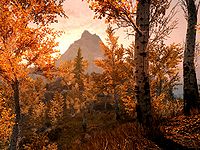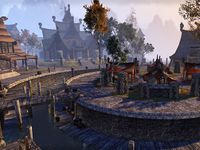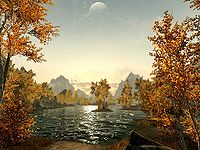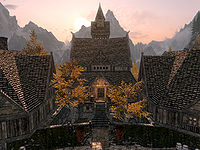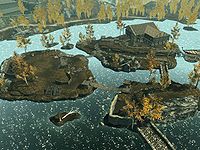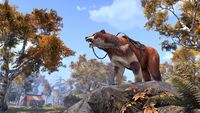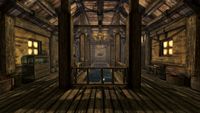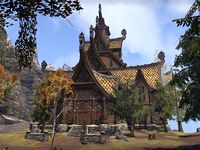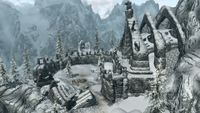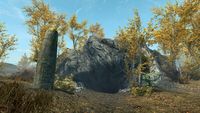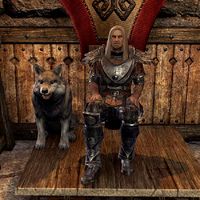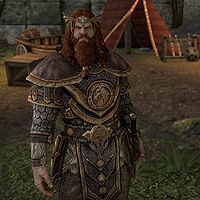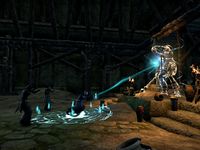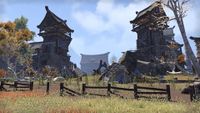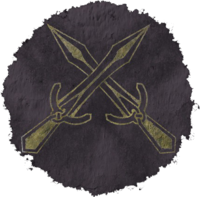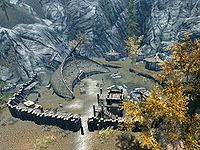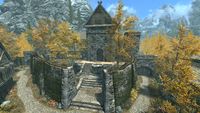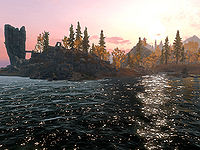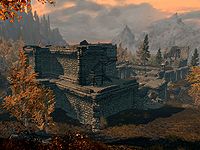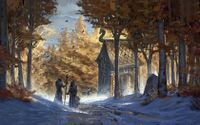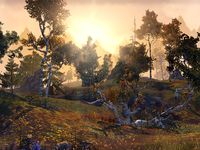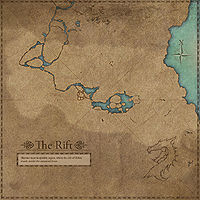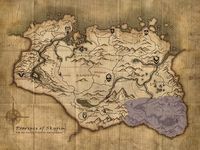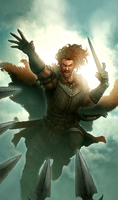Lore:The Rift
| The Rift | |
|---|---|
| Type | Region |
| Continent | Tamriel |
| Province | Skyrim |
| Subregions | Ragged Hills Smokefrost Peaks Stony Basin Ysgramor's Teeth |
| Appears in | Skyrim, ESO, Legends |
The Rift (sometimes called Rift Hold)[1] is a large region in the southeastern portion of Skyrim and one of the Old Holds, the eastern Skyrim territories isolated by geography and choice as the local Nords have stuck close to ancient traditions.[2] The Rift is distinct for its temperate climate and autumn forest, thanks to the mountains surrounding it blocking extreme temperatures from the east and north.[3] The capital of the hold is Riften, formerly the epicenter of a vast trading network between Skyrim and Morrowind.[4]
The Rift is traditionally bordered by Eastmarch to the north, Falkreath Hold to the west, the Jerall Mountains to the south, the Velothi Mountains to the east, and Whiterun Hold to the northwest.[5] From across the provincial border, the region is neighbored by County Cheydinhal in northern Cyrodiil[6] and both the general Redoran District and Stonefalls in northwest Morrowind.[7]
Contents
Society and Geography[edit]
Demographics[edit]
Historically, the Rift falls within Skyrim's borders and has been populated by the Nords, who primarily work the local waters of the region. The hold's capital of Riften sits on the edge of Lake Honrich, where a booming fishing industry takes place.[4] Two of the most well-known families in the hold include the Black-Briar and the Snow-Shod clans, but there are several other notable clans, like the Ironarm[8] and Ironhand clans.[9] As one of the Old Holds, many locals retain ancient traditions, and outsiders were a rarity by the end of the Second Era,[2] but by the Fourth Era, the capital functioned as a major trading hub in northeast Tamriel.[4]
The main road between provinces is the southeastern road near Fullhelm Fort, which leads into northwestern Morrowind.[10][11] Fort Virak is the primary stronghold that protects this inter-province route, while the nearest city is Kragenmoor to the south. Because of the Rift's proximity to the province, the Dunmer live throughout the region. And just like the locals that already inhabit it, they are expected to work just as hard and contribute to society.[12][13]
Even before the mass exodus during the Red Year, the Dark Elves contributed greatly to Riften, and some families, such as the Rothalens garnered influence.[8] Overall, the Dunmer assimilated to life in the Rift, and despite all the problems that come out of the capital, none of it could be traced to them.[13] To a lesser extent, some routes lead into Cyrodiil. Travelers from the south typically come from Cheydinhal in the Nibenay Basin[6] and Gromm's Pass provides goblins, including the Three Feather Tribe, access across the border.[14] In the late Merethic Era, the Nedes also lived in the region.[15]
Giants live in the region's hinterlands, either deep in the forest or in the snowy mountains.[16] A tribe of them can be found in the Lion's Den,[15] but also in places such as Honeystrand Hill and Mammoth Ridge.[11] After the Kragen Clan traveled west across the Velothi Mountains into Skyrim, many other clans followed suit and established holdings across the province.[17] The Dwemer lived primarily in the southwestern portion of the Rift, with the only known city in the area being Avanchnzel southwest of Lake Honrich. Beyond that, there are two dwarven outposts accessible from the surface; Bthalft, which is south of Lake Geir, and Rkund, high in the Jerall Mountains and south of Lake Honrich.[10][11]
Culture and Industry[edit]
Throughout its history, Riften was a major center of activity between Skyrim and Morrowind for travelers and traders alike. Since it is based on Lake Honrich, the city's main industry is fishing. Boats and skiffs dot the lake for days on end[4] and the fishery is the largest building in the city's Plankside district.[10]
Mead brewing became another significant industry in the Second Era. Riften became famous for its blackberry mead and built meaderies to capitalize on it.[18] One family that took advantage of this and gained success was the Black-Briar family, whose signature mead is sold across the province. The Black-Briars imported their honey from Goldenglow Estate on the Isle of Gold.[19]
Skald's Retreat, used as a gathering place for bards from across Skyrim, existed on the isle before Goldenglow.[20] One of the school's most well-known students was the High King of Eastern Skyrim, Jorunn the Skald-King.[21] For a time, the Companions of Skyrim were based in Fallowstone Hall, a mead hall on the hills overlooking Shor's Stone.[22] Geirmund's Hall is a tomb in the center of Lake Geir and it was built for the eponymous archmage that saved the Rift in the early First Era.[23] Every year, a festival and competitions are held on the island by the local Thane to name a worthy challenger the title of Geirmund's Guardian, a warrior who pledges to protect the Rift.[24][25]
For the longest time, the main religious faction in the Rift was the Benevolence of Mara, the temple dedicated to Mara. They were based in the city's local temple, which also contained the Hall of the Dead.[26][27] Stendarr's Beacon is a historical shrine to the divine of the same name. The Vigilants of Stendarr took up residence in the tower in the Fourth Era.[28] The Thieves Guild of Skyrim are based in Riften but exclusively work in the hold's capital since they find little prospect beyond it.[8] A mysterious sect of master thieves called the Nightingales are associated with the guild, and although most people dismissed it as a myth,[29] the trinity existed sometime after the Alliance War took place.[UOL 1]
The Nightingales are servants to the Daedric Prince of Darkness and Shadows. They are based in Nightingale Hall near the Shadow Stone and have some influence over the Thieves Guild.[30] The Scribes of Mora was a daedric cult that worshipped Hermaeus Mora. They built one of their libraries in the Rift, where many rifts to other planes of Oblivion were discovered under the earth.[31] A shrine dedicated to Malacath is found on the eastern edge of Rift Hold, deep in the Velothi Mountains.[32] One of the mythical luminaries, specifically the Gryphon has ties to the Rift. Across the region are his various wards that when unlocked, would provide a fragment of a key to their special domain. Clues were left behind in one of its fables and with her unique abilities, Archmage Ulfsild the Evergreen eventually encountered the luminary.[33][34]
The Great Riften Road is the hold's main thoroughfare. It starts from the Lion's Den, a valley that bridges Falkreath Hold to the southwest, and continues east along the southern Treva Riverbank until it reaches Riften's south gate. Beyond the city, it diverges north into Eastmarch and east toward the border. The road also splits north around Honeystrand Hill to Ivarstead and northeast where Lake Geir meets the Treva, toward Eastmarch's southern road.[10][35]:594 From the mid-Second Era to the late Third Era, a riverside town called Nimalten was located on this second crossroad,[11] but was not present by the Fourth Era.[10][36] There was a secondary road that connected the road between Nimalten, Lake Geir, and Shor's Stone by passing through Vernim Woods and Northwind Mine. A third, minor road existed near Fullhelm Fort and around Forelhost mountain to the caves underneath Trolhetta.[11] Both of these roads were gone by the Fourth Era.[10]
Ecosystem[edit]
The Rift's largest biome, which encompasses most of it is called the Autumnal Forest. It is made up of deciduous birch trees, interspersed with pine trees and smooth rocks from the glacial movement in prehistoric times.[35]:594 Smokefrost Rosewood is a distinct type of tree that grows in southeastern Rift Hold.[37]
Several mountains form in and around the Rift. Forelhost is a mountain in the middle of Smokefrost Peaks, with a Dragon Cult temple of the same name at its peak.[38] Northwind Summit sits on Ysgramor's Teeth, overlooking Eastmarch near Shor's Stone.[39] One of its largest mountains is Trolhetta, approximately near the intersection between the Jerall, Valus, and Velothi mountains.[40]
On the surface, the Rift boasts an ecosystem one can expect from a year-round habitable part of Skyrim. Mountain Flowers of every variety, as well as canis root,[41] scaly pholiota,[42] and nirnroot can be found in the wild. Mushrooms grown in caves, such as fly amanita,[43] glowing mushrooms,[44] imp stool,[45] Namira's rot[46] and the white cap[47] can also be found in the Rift. A species of mushroom found in Cyrodiil called Steel Blue Entoloma can be located in Gromm's Pass.[48]
To meet the demand for mead, honey farms can be found in the Rift, with one of the largest operations located on the Isle of Gold.[19] Blackberries are the key ingredient in the city's most well-known mead and even the hold's signature cheese, Riftwash. It is goat cheese washed in the mead and covered in wax dyed in blackberry must.[18] Foxroot is an exceptionally rare plant found only in eastern Rift Hold, in a historically sacred land around Lost Prospect Mine. It is commonly used in clever magic.[49][50]
As a temperate region in southeast Skyrim, the Rift's wildlife is emblematic of this. Common creatures that can be found elsewhere include bears, frostbite spiders, the pine thrush, sabre cats, and wolves. Even guar, which comes from Morrowind can be found here. Pony guars are popular pets in Riften's aristocracy and traditional Nords like to dress them in Frostbane garb.[51] But unique creatures to the region can also be found in the wilderness. A sweetroll grizzly bear is rare and lives in the Autumnal Forest, toward the Jerall Mountains.[52] The Coalhorn Ram native to the Riften region perceive anything as a threat and only its owner can interact with it without getting attacked.[53]
Since the Rift's central feature is the twin lakes; Geir and Honrich, and the Treva River that bridges them, the hold contains a vast ecosystem of fish and other aquatic animals. Some of the most common types of fish and animals are catfish, nordic barnacle,[54] and salmon. In the lakes, the rarest fish include the Ilinalta trout, ice koi, jarl salmon, and zebra oto. In the Treva River, there is the grouper, muskellunge, sockeye salmon, and white roughy. In foul water, one can find the bream, skate, skorrn, and sulfursucker.[55]
History[edit]
- For the history specific to the city, see the: History of Riften
The Five Hundred and the Giant of Legend[edit]
Before the Nords lived in the Rift, it was populated by the Snow Elves[56] and one of their only known settlements was an unnamed location now underneath Fort Greenwall.[57] In the late Merethic Era, the Five Hundred Companions landed on the shores of Skyrim and embarked across the land to seek out new territory and eliminate the elves that sacked Saarthal.[56]
The crew of the Fallowfire, led by Captain Gurilda Sharktooth, traveled south and found the tall mountains at the edge of Eastmarch, which they called; Ysgramor's Teeth. After discovering a traversable pass through the mountains, they discovered a region split by deep canyons and swift rivers, inspiring them to name it "The Rift".[56]
They pledged to scour the land, hunt down every elf village, and burn them to the ground.[nb 1] The elves eventually decided to fight back and gathered in large numbers on a rocky hill in northeast Rift. The battle lasted all day and although the Fallowfire emerged victorious, Captain Gurilda and several other companions died in battle. Those that lived claimed the Rift in the name of Ysgramor, and honored the dead by building their tomb on the hillside. The Fallowfire's first mate, Vikord One-Ear, declared that the crew would settle in the Rift and cease their journey. They built the great Fallowstone Hall over the tomb, from which they presided over the region.[56]
Over the course of their expedition across newfound land, the Five Hundred Companions faced tribulations from the locals. Beyond the Snow Elves, Ysgramor's greatest threat was the half-giant Sinmur; who led the giant clans of ancient Skyrim against the Harbinger.[58] In the great battle against the giants, many warriors died in battle, from both the ancient Nords and the giants until both leaders engaged each other in combat. Ysgramor emerged victorious[59] and the dead Companions would continue to serve him as protectors of the Rift. The heroes Bron Darkhammer and Jalarma Fireheart sacrificed much to defeat Sinmur, so they were given the duty of guarding Sinmur's tomb deep underneath the mines of modern-day Shor's Stone.[60] Two Companions that died in battle, Hakra and Valdur, were buried in the western corners of the Rift, where they would serve as eternal protectors of the region.[61]
Early History[edit]
By the late Merethic Era, the Rift was mostly populated by the ancient Nords, also called the Nedes.[62] The Dragon Cult built temples across the Rift's mountain country, such as Angarvunde in the Ragged Hills, Arcwind Point in the Jeralls, and Forelhost at the top of the eponymous mountain.[10] The Lion's Den in southwest Rift Hold was a historical hunting ground for Nedes that sought furs.[15] They also used the pass toward Stonefalls to invade the Chimer since long before Red Mountain's first eruption.[63] The Nedic invasion of Stonefalls took place in the early First Era and the Rontha were among the largest tribes to attack.[62][64]
In the aftermath of the Dragon War,[65] Whiterun Hold held control of territory that is part of modern-day Rift Hold, namely Hillgrund's Steading at the base of the Throat of the World.[66] Despite the war's outcome, one sect managed to survive into the early First Era, namely the cult in Forelhost. It was discovered by the Nordic commander, Skorm Snow-Strider on the 27th of Sun's Dawn in 1E 139, as he was scouting the Rift's outlying territories for any remaining Snow Elven strongholds. The siege on the temple lasted for several weeks and they managed to enter it by the 5th of Morning Star in 1E 140. They found the entire cult dead, and their drinking water was discovered to have been poisoned after a member of the siege force succumbed to it. A magical barrier protected the upper door in Forelhost's courtyard and Skorm's mages believed that it would stay for decades. The invaders left on the 7th of Morning Star, but Skorm left his journal there for anyone that tried to delve into the temple.[67]
Sometime soon after, three brothers of the late Gauldur wreaked havoc across ancient Skyrim, and High King Harald sent his archmage, Geirmund to intervene and fight them. The last brother and middle child, Sigdis Gauldurson terrorized the Rift and was eventually cornered near Ivarstead, where he challenged the archmage, knowing he was honor-bound to do so. The two were said to be of equal strength and in the end, both died together on a field near Ivarstead. Harald had a tomb built in the middle of the lake that bears Geirmund's name, where the mage would eternally guard Sigdis's tomb.[23][68]
In Morrowind, the Chimer and Dwemer formed the First Council which succeeded in expelling the Nords from the region in 1E 416.[69] Peace among Chimer and Dwemer was not accepted by all, and several dwarven clans chose exile over accepting the First Council.[17] Four clans established city-states across Skyrim and formed an alliance to harness Aetherium, a rare blue crystal of magical potency. Together they built a forge for this new material aptly named the Aetherium Forge, deep in the hills of southwest Rift Hold. The alliance was short-lived as the four clans and their rivals fought for control of the forge. The subsequent invasion at the hands of High King Gellir hastened their downfall, ending with the alliance and the forge lost to history. The scholar Taron Dreth speculated that the forge was destroyed by the Nords or the Dwemer themselves.[70][71]
1E 2703 saw the Tsaesci of Akavir land on the shores of Skyrim and Morrowind and cut a bloody swathe down to the Pale Pass. The armies that came from Morrowind traveled west across the mountains to bypass Skyrim's borders. Archaeologists of the Antiquarian Circle discovered an Akaviri Lord's banner in the Rift and a scholar of the society, Ugron gro-Thumog explain that they conquered huge portions of both affected provinces.[72] Assumingly, the Akaviri would have traveled west through the Rift and into Falkreath Hold until their armies were defeated by Reman I on the Cyrodilic border as the story goes.[73]
The Rift in the Second Era and the Akaviri Invasion[edit]
After the death of High King Logrolf in 2E 431, contention for the throne had risen when the Jarl of Solitude, Svartr claimed that the High King's daughter, Freydis was not a legitimate heir to the throne. Although the Crown of Verity chose the latter, a partial moot chose Svartr. Since then, two kingdoms were formed between the east and west of Skyrim. The Rift and the rest of the Old Holds followed Freydis as their High Queen and formed the Kingdom of Eastern Skyrim.[74][75]
On several occasions throughout the Second Era, the Rift was plagued with disaster. The Jarl's son became infected with vampirism and spent a fortune to keep him prisoned in a fort southeast of the city. When the son was put down by his guardsmen, the Jarl banished them. They continued their service as vampire hunters and became the early Dawnguard. The Fourth Era leader of the reformed Dawnguard described the events as a dark point in the hold's history.[76]
At another time, an earthquake erupted in the region and caused the Redwater Spring, a former place of worship for Arkay to be buried under the earth. It has since devolved into legend as a fabled source of power for vampires.[77] Sometime prior to 2E 467,[78] the Orcs of Yashnag gro-Yazgu's chiefdom attempted to expand east into the region. The furthest they managed was the northwest shore of Lake Honrich, where they sacked Faldar's Tooth. Since then, the fort was abandoned and the Jarls of Riften lacked funds to rebuild it.[79]
In another instance, Dark Elves raided and burned down farms before sacking Riften. One Nord named Unnvald Ironhand, whose family died in the fires began to assemble warriors from across the province and raid Morrowind over the course of years. They would sail once or twice a year and cause severe damage, such as when they sacked Davon's Watch.[63] One of his most well-known conflicts was the Battle of the Bones, in which Unnvald defended Fullhelm Fort from the undead horde summoned by necromancers from Fort Virak.[80]
In 2E 572, the Kamal of Akavir, led by Ada'Soom Dir-Kamal landed in eastern Skyrim and besieged Windhelm. At the time, Prince Jorunn was in Riften once the news had reached him and after he returned to the city, he disappeared from the public. As the East would report it, he quietly made his way to the Throat of the World and scaled the mountain to seek help from the Greybeards of High Hrothgar.[21] There, they bestowed upon him a thu'um that could summon a hero from Sovngarde and in this case, it was Wulfharth. Although Western Skyrim was dubious of this claim, it is confirmed that Jorunn and his ally assembled an army from the Rift and outer Eastmarch, and fortified Riften for the incoming Akaviri.[21][81] Ada'Soom Dir-Kamal sacked Fort Greenwall[82] before he bypassed Riften, where he found it defended by angry Nords. He eventually made his way southeast to break through Fort Virak and lose in Stonefalls.[21][81]
In the aftermath of the Second Akaviri Invasion, Jorunn the Skald-King forged an alliance with the Dunmer of Morrowind and the Argonians of Black Marsh called the Ebonheart Pact.[83] Terms were decided between the various factions, including the banning of any reference to Unnvald Ironhand. Statues of his likeness were torn down in Riften and Windhelm while songs of his exploits were forbidden. He was offered the Thanedom of Fullhelm Fort, which he initially declined before he was threatened with persecution from the Ordinators. He reluctantly accepted it and remained there for roughly ten years.[63]
The Worm Cult and Sinmur's return[edit]
On the 3rd of Frostfall in 2E 582, three border clans of the Reach, the Boneshapers, the Rageclaws, and the Stonetalons formed an alliance together to launch an invasion on the Rift.[84] They were approached by the Order of the Black Worm led by Thallik Wormfather, who promised them the dark magic of Molag Bal to make them stronger. In exchange, they had to resurrect Sinmur's spirit for the cult.[85] The start of this conflict began when the Boneshapers attacked Shor's Stone and entered the ebony mine where Sinmur had been resurrected.[86]
A secondary attack took place in Fallowstone Hall, where the Rageclaw Clan took Wuuthrad from the hall's inner vault. Both the Ebonheart Pact and the Companions rallied together to fight the threat but despite their best efforts were unsuccessful.[87] With keeping their side of the bargain, the Reach clans gathered in Vernim Woods, where the Worm Cult prepared a ritual that infused the three clans with Molag Bal's energy. A battle took place between the allied Reachfolk and the Ebonheart Pact. The conflict ended with the deaths of the clan chieftains, and the Worm Cult routed.[88]
While the King's Arrow searched for the Worm Cult in the Ragged Hills, Sinmur's spirit stomped through Boulderfall Pass[89] and reached Smokefrost Peaks, where he displaced many people and forced them to flee to Riften. The Worm Cult went to the western Rift and splintered into two groups to enslave Hakra and Valdur's spirits in Pinepeak Cavern and Taarengrav respectively. With their spirits, Thallik Wormfather planned a ritual in Arcwind Point to enhance Sinmur's power with Wuuthrad. A battle between the Pact and Worm Cult commenced in Honrich Tower, and despite the cult's growing army, they were defeated. The King's Arrow infiltrated Arcwind Point and killed Thallik Wormfather. However, his spirit remained and infused itself with Sinmur.[90]
The merging ritual caused Wuuthrad to break, and its pieces were taken by the Worm Cult to areas across the Smokefrost Peaks. Sinmur emerged with even greater power[90] and with it, sacked Riften in his wake. The city's northern wall was wrecked and many of its citizens were caught in the rubble. The King's Arrow assisted people and uncovered a plot from within the city. In turn, they found their first shard of Wuuthrad.[91] The Pact tracked Sinmur and the Worm Cult to Trolhetta and Jorunn the Skald-King amassed an army at the base of the mountain for a final battle. Using the innate power of Wuuthrad's shards and runic braziers, the King's Arrow was able to slay Thallik Wormfather and Sinmur.[92]
The Rift in the Third Empire[edit]
By the late Second Era, the province of Skyrim came under the Third Empire's control and the Imperial Army amassed their invasion forces here before crossing the border into Morrowind.[93] The Imperial Legion was stationed in Riften and sometime after the sack of Mournhold, a young Barenziah and her companion found their way here. Prior to this, they passed through Sunguard, a town in southeast Skyrim before settling in Riften,[94][95] where they supposedly become associated with the Thieves Guild.[96] It was through a failed scheme did she become acquainted with the Imperial Commandant, Symmachus and ultimately returned to Mournhold to reclaim her birthright as the Queen of Morrowind.[96][97]
By the Third Era, the Rift and the holds were ruled by Kings.[98][99] When the War of the Red Diamond broke out in 3E 121, disgruntled kings of Skyrim supported Queen Potema of Solitude in her fight against the Empire, at the time ruled by Empress Kintyra II.[100] By the time the war was in full effect, the entire province of Skyrim fought for the Wolf Queen and her son, Uriel III.[101] Years later in 3E 433, the region and the Old Holds at large were laid to waste during the Oblivion Crisis.[102]
The Fourth Era and onwards[edit]
In conjunction with the late Third Era, the early Fourth Era was a drastic moment in time for the region and the province. The Red Year (4E 5) and the Accession War a year later were breaking points in Morrowind's history and resulted in a large exodus of its population west across the border. The Dunmer population that lived in Riften and the hold were able to acclimate to their new environment, unlike their brethren to the north[13] that faced contempt in Winterhold,[103] and later in Windhelm.[13]
On a similar scale, the Orcs fled southeast into Hammerfell and Skyrim after Orsinium was sacked. And while some stayed in Hammerfell to build another iteration of the city, some traveled further east into Skyrim[104] and built strongholds across the province's outer reaches. The Orcs built Largashbur in the southern Rift and at the base of the Jerall Mountains.[105]
On the Void Nights in 4E 98, the Jarl of Riften was assassinated and Hosgunn Crossed-Daggers took their position. The people believed he was responsible for his predecessor's death and protested in response. Once he took the throne, Hosguun dispatched the city guard to quell the gathering and initial a curfew, one that would invoke the death penalty on the second offense. He ruled the hold for forty years, imposing heavy taxes and governing under an iron fist. 4E 129 marked the end of his reign when people gathered in overwhelming protest and set fire to his castle while he was in it. The ensuing fire spread across the entire city and although it was repaired five years later, Riften had become a shadow of its former self.[4]
When the Skyrim Civil War started in 4E 201, the Rift was ruled by Jarl Laila Law-Giver. She allied with the Stormcloaks despite having doubts about their crusade.[106] The Stormcloak garrison in the region was led by Gonnar Oath-Giver[107] and Fort Greenwall was a point of contention in the Rift's affiliation.[108] The Thieves Guild of Skyrim, formerly one of the most influential organizations of the province, had fallen out of glory over the course of years and was limited to operations in Riften. Theories documented by the author Nithilis Lidari report that the loss of their guildmaster, a figure named Gallus, played a major role in the Thieves Guild's downfall.[109]
In that same year, the Last Dragonborn of prophecy appeared in Skyrim after dragons returned from the dead and roamed the land. The warrior was summoned by the Greybeards of High Hrothgar and traveled to the town of Ivarstead, before scaling the Throat of the World.[110] Sometime later, they made their way to Riften and entered the city's Ratways to find a long lost loremaster of the Blades named Esbern. While doing so, the Thalmor tracked them and attempted to kill them but failed as they escaped the city.[111] Meanwhile, a vampiric threat orchestrated by the ancient Volkihar Clan began to emerge across Skyrim, and a new generation of Dawnguard rose to the occasion. Led by an ex-Vigilant of Stendarr known as Isran, they occupied the old Fort Dawnguard and word spread of his call to action.[112]
Known Rulers[edit]
The Jarl of the Rift is based in the region's historical capital of Riften, but their seat of power from within the city has changed over the years. In the mid-Second Era, no castle was present in Riften.[11] When Hosgunn Crossed-Daggers became Jarl in the first century of the Fourth Era, his people built a castle since remembered as Hosgunn's Folly. Construction took place over seven years. The structure would be destroyed in the fires of 4E 129, not lasting beyond his reign.[4] In its place, the Jarl has resided in Mistveil Keep.[27] Its name comes from an old-standing tradition in which the largest manor in southern Riften is called Mistveil Manor.[113]
As one of the Old Holds, the Nords of the Rift value heritage and show reverence for their hereditary leaders.[2] Under the Third Empire, all of Skyrim's monarchs were known as Kings/Queens,[98][99] at least from an Imperial's perspective.[114]
- The Second Era
- The Third Era
- The Fourth Era
- Unnamed Jarl of Riften (4E ? – 4E 98)[4]
- Jarl Hosgunn Crossed-Daggers (4E 98 – 4E 129)[4]
- Jarl Laila Law-Giver (ca. 4E 201)[107]
Notable Locations[edit]
- Blessed Crucible
- A legendary gladiatorial arena hidden underneath the Velothi Mountains and Trolhetta
- Fallowstone Hall
- The original Companions mead hall; built from the remains of the Fallowfire
- Forelhost
- A large Dragon Cult stronghold at the top of a mountain. It was the last active cult stronghold until its downfall in 1E 139
- Fort Dawnguard
- An old fort in Dayspring Canyon and headquarters of the Dawnguard
- Fort Greenwall
- A stronghold on the main road between Riften and Shor's Stone
- Lake Geir
- The smaller of two lakes in the Rift. It is named after Archmage Geirmund, who fought valiantly to the death
- Lake Honrich
- The larger of two lakes in the Rift and the center of the hold's industry.
- Ivarstead
- A lumber town at the base of the Throat of the World, contains the path to High Hrothgar
- Riften
- The capital city of the hold, located on the eastern shore of Lake Honrich
- Ruins of Bthalft
- A small set of Dwemer ruins in the wilderness that contains the Aetherium Forge
- Shor's Stone
- An old ebony mining town on the pass between Eastmarch and the Rift
- Treva River
- The long, winding river that splits the Rift from the north and south
Gallery[edit]
"The Autumnal Forest of the Rift Hold" – Painted by Flaccus Terentius[118]
The Rift ca. 2E 582
Rift Thane (Legends)
Notes[edit]
See Also[edit]
- For game-specific information, see the Skyrim, Elder Scrolls Online, and Legends articles.
Books[edit]
- Rilaso's Guide to Tamriel, Ch. 21 by Rilaso — A cautionary guide warning against the dangers of the Rift
- Songs of the Return, Volume 49 — Part of the traditional legend of Ysgramor and his Five Hundred Companions
References[edit]
- ^ Nimalten Barrow loading screen text in ESO
- ^ a b c Pocket Guide to the Empire, 1st Edition: Skyrim — Imperial Geographical Society, 2E 864
- ^ The Rift loading screen text in ESO
- ^ a b c d e f g h Of Crossed Daggers — Dwennon Wyndell
- ^ Map of Skyrim – The Elder Scrolls V: Skyrim
- ^ a b An Explorer's Guide to Skyrim — Marcius Carvain, Viscount Bruma
- ^ Map of Tamriel – The Elder Scrolls Online
- ^ a b c Rivers of Profit in Riften — Eyes-With-Intent
- ^ Lineage of Clan Ironhand contraband text in ESO
- ^ a b c d e f g The Rift in Skyrim
- ^ a b c d e f The Rift in ESO
- ^ Demographics of the Rift – The Elder Scrolls V: Skyrim
- ^ a b c d Scourge of the Gray Quarter — Frilgeth Horse-Breaker
- ^ Letter to Clexius — Avanessa Calladius
- ^ a b c Into the Lion's Den
- ^ All About Giants — Bonorion the Wanderer
- ^ a b Arkngthamz-Phng — Neramo
- ^ a b Cheeses of Skyrim: Riften, Falkreath — B.
- ^ a b Ungrien's dialogue in Skyrim
- ^ Engling's dialogue in ESO
- ^ a b c d Jorunn the Skald-King — Helgreir Lute-Voice, Bard of Windhelm
- ^ Vigrod Wraithbane's dialogue in Skyrim
- ^ a b Geirmund's Oath
- ^ Runehild's dialogue in ESO
- ^ Thane Vofknir's dialogue in ESO
- ^ Captain Viveka's dialogue in ESO
- ^ a b Riften in Skyrim
- ^ Stendarr's Beacon in Skyrim
- ^ Nightingales: Fact or Fiction? — Wilimina Roth
- ^ The Nightingales Vol. 1 — Gallus Desidenius
- ^ Keshargo's dialogue in ESO: Scribes of Fate
- ^ Giant's Grove in Skyrim
- ^ Fable of the Gryphon
- ^ Ulfsild's Echo of the Lens' dialogue in ESO: Gold Road
- ^ a b The Elder Scrolls V: Skyrim: Prima Official Game Guide — David Hodgson
- ^ Ask Us Anything: Ebonheart Pact
- ^ Wooden Drinking Goblet item description in ESO
- ^ Forelhost in ESO
- ^ Northwind Summit in Skyrim
- ^ Trolhetta in ESO
- ^ Canis Root in Skyrim
- ^ Scaly Pholiota in Skyrim
- ^ Fly Amanita in Skyrim
- ^ Glowing Mushroom in Skyrim
- ^ Imp Stool in Skyrim
- ^ Namira's Rot in Skyrim
- ^ White Cap in Skyrim
- ^ Steel-Blue Entoloma in Skyrim
- ^ The Crow's dialogue in ESO: Gold Road
- ^ Safeguards of the Gryphon — The Gryphon
- ^ Frostbane Pony Guar pet description in ESO
- ^ Sweetroll Grizzly mount description in ESO
- ^ Riften Coalhorn Ram mount description in ESO
- ^ Nordic Barnacle in Skyrim
- ^ The Rift fish catches in ESO
- ^ a b c d Songs of the Return, Volume 49
- ^ Lady Clarisse Laurent Answers Your Questions — Lady Clarisse Laurent and Stibbons
- ^ Skald Svari's dialogue in ESO
- ^ Songs of the Return, Volume 27
- ^ Unearthed story quest in ESO
- ^ Valdur's dialogue in ESO
- ^ a b Sorcerer Vunal's dialogue in ESO
- ^ a b c Hallfrida's dialogue in ESO
- ^ Nedic Wineskin antiquity codex entries in ESO: Greymoor
- ^ Farengar Secret-Fire's dialogue in Skyrim
- ^ Holdings of Jarl Gjalund — Slafknir the Scribe
- ^ Skorm Snow-Strider's Journal — Skorm Snow-Strider
- ^ Daynas Valen's Notes — Daynas Valen
- ^ Pocket Guide to the Empire, 3rd Edition: All the Eras of Man, A Comprehensive History of our History — Imperial Geographical Society, 3E 432
- ^ The Aetherium Wars — Taron Dreth
- ^ Katria's Journal — Katria
- ^ Akaviri Lord's Banner antiquity codex entries in ESO: Greymoor
- ^ Legacy of the Dragonguard — Kiasa-Veda, the Chronicler of Blades
- ^ The Crown of Freydis — Taleon Mythmaker
- ^ Loremaster's Episode of ESO-RP ZOS Interview
- ^ a b c Isran's dialogue in Skyrim: Dawnguard
- ^ Venarus Vulpin's Journal — Venarus Vulpin
- ^ Orcs of Skyrim — Thora Far-Wanderer
- ^ Faldar's Tooth loading screen text in ESO
- ^ Battle of the Bones Memorial
- ^ a b The Second Akaviri Invasion — Yngmaer Raven-Quill, Historian Royal of the Bards' College, Solitude
- ^ Fort Greenwall loading screen text in ESO
- ^ Guide to the Ebonheart Pact
- ^ Treaty of the Three Clans
- ^ Worm Nightfrenzy's dialogue in ESO
- ^ Beneath the Stone story quest in ESO
- ^ Storming the Hall story quest in ESO
- ^ Through the Shroud story quest in ESO
- ^ Centurion Gjakil's dialogue in ESO
- ^ a b Shattered Hopes story quest in ESO
- ^ In His Wake story quest in ESO
- ^ Stomping Sinmur story quest in ESO
- ^ On Morrowind — Erramanwe of Sunhold
- ^ Biography of Barenziah, v 1 — Stern Gamboge, Imperial Scribe
- ^ The Real Barenziah, v 1 — Anonymous
- ^ a b The Real Barenziah, v 2 — Anonymous
- ^ Biography of Barenziah, v 2 — Stern Gamboge, Imperial Scribe
- ^ a b Pocket Guide to the Empire, 3rd Edition: The Throat of the World: Skyrim — Imperial Geographical Society, 3E 432
- ^ a b c Riften location and rumors in Arena
- ^ Brief History of the Empire v 1 — Stronach k'Thojj III
- ^ Brief History of the Empire v 2 — Stronach k'Thojj III
- ^ Tamriel Gate Response generic dialogue in Oblivion
- ^ Brelyna Maryon's dialogue in Skyrim
- ^ Lord of Souls — Greg Keyes
- ^ Largashbur in Skyrim
- ^ Laila Law-Giver's dialogue in Skyrim
- ^ a b Riften Stormcloak court in Skyrim
- ^ Fort Greenwall's role in the Civil War questline in Skyrim
- ^ Fall from Glory — Nithilis Lidari
- ^ The Way of the Voice story quest in Skyrim
- ^ A Cornered Rat story quest in Skyrim
- ^ Durak's dialogue in Skyrim: Dawnguard
- ^ Old Mistveil Manor loading screen text in ESO
- ^ Legate Fasendil' dialogue in Skyrim
- ^ Silver Bolts skill description in ESO
- ^ Goharth Ironbelly's dialogue in ESO
- ^ Hallfrida's dialogue in ESO
- ^ The Improved Emperor's Guide to Tamriel: Skyrim — Flaccus Terentius, 2E 581
- ^ Dragon Language: Myth no More — Hela Thrice-Versed
- ^ Dismay shout in Skyrim
Note: The following references are considered to be unofficial sources. They are included to round off this article and may not be authoritative or conclusive.
